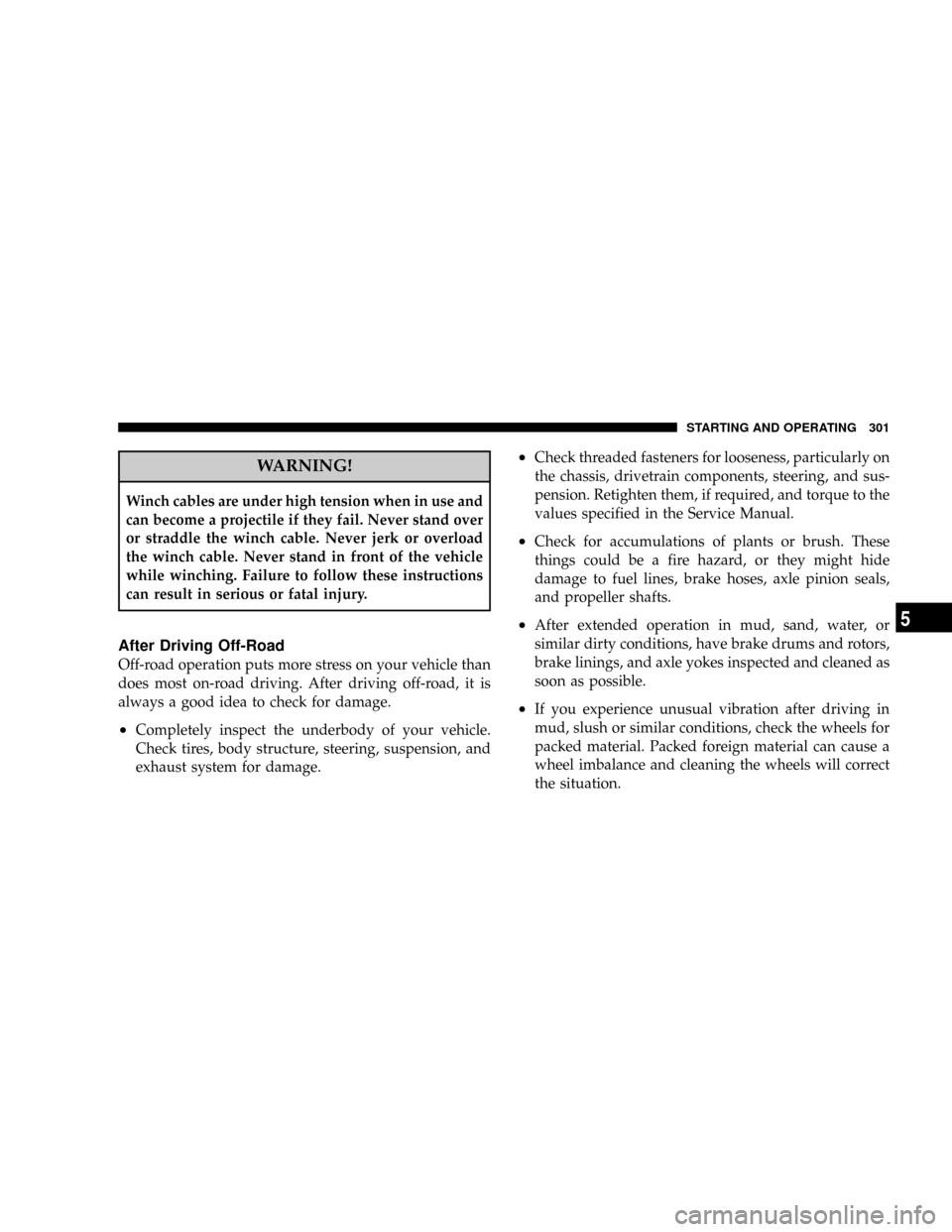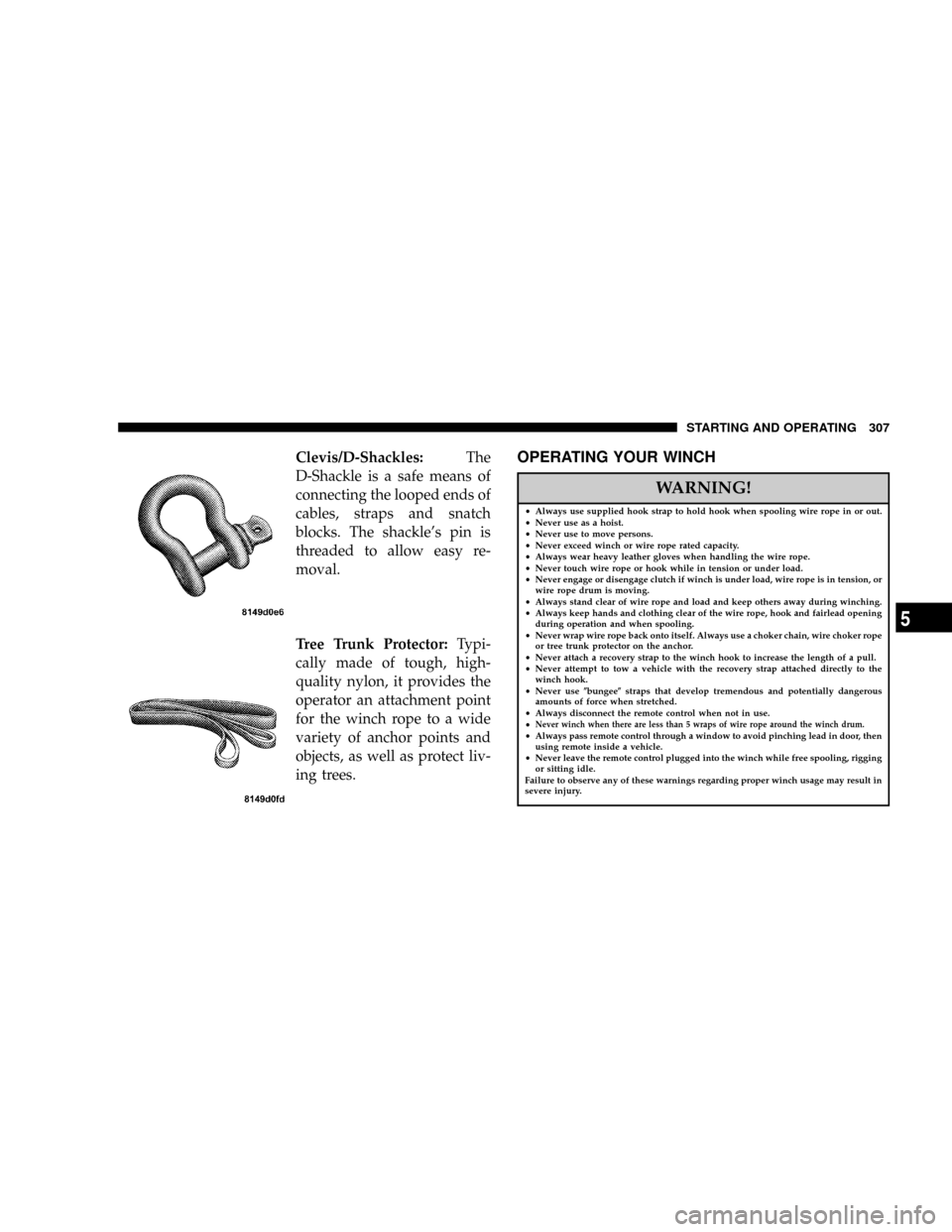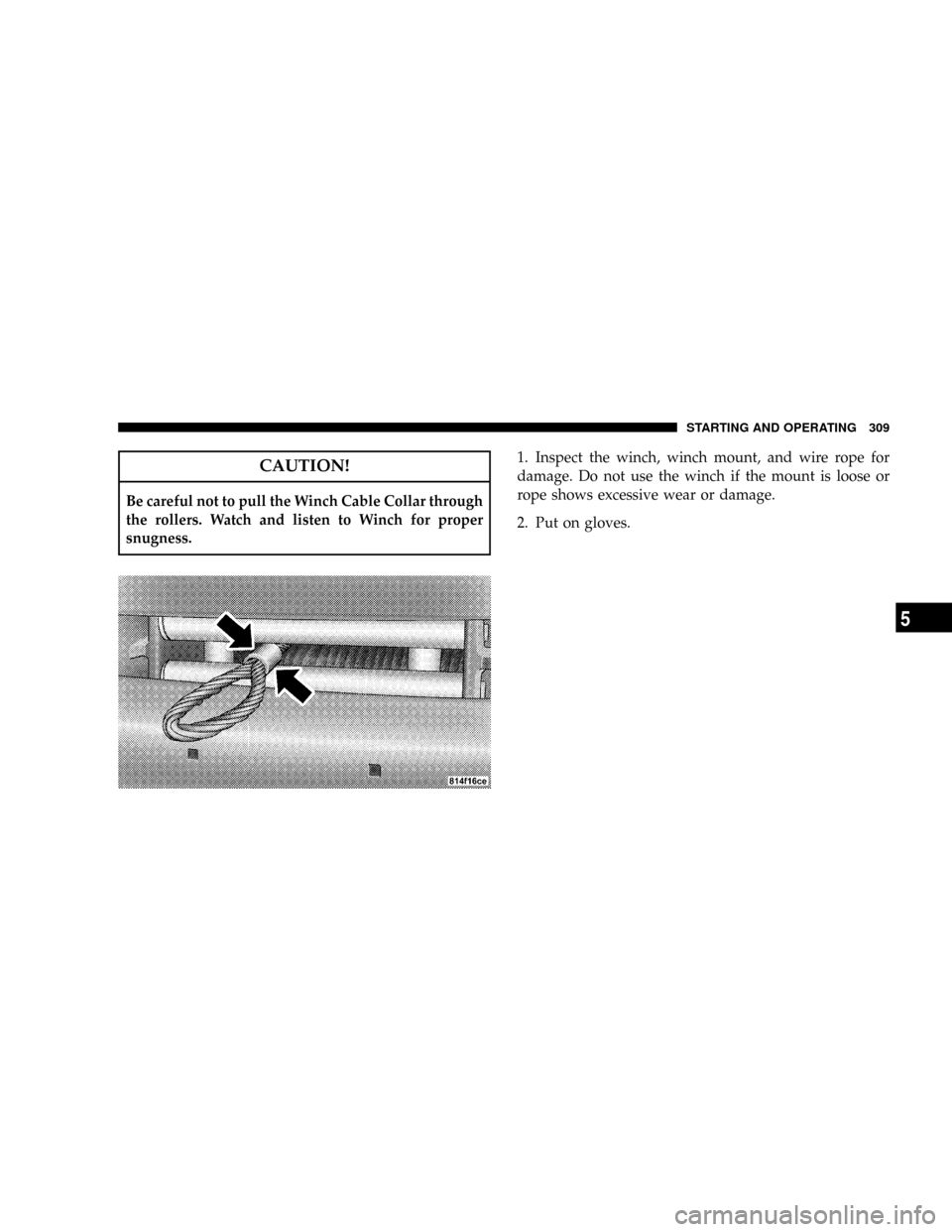DODGE RAM 2500 POWER WAGON 2008 3.G Owners Manual
Manufacturer: DODGE, Model Year: 2008, Model line: RAM 2500 POWER WAGON, Model: DODGE RAM 2500 POWER WAGON 2008 3.GPages: 504, PDF Size: 8.17 MB
Page 301 of 504

WARNING!
Winch cables are under high tension when in use and
can become a projectile if they fail. Never stand over
or straddle the winch cable. Never jerk or overload
the winch cable. Never stand in front of the vehicle
while winching. Failure to follow these instructions
can result in serious or fatal injury.
After Driving Off-Road
Off-road operation puts more stress on your vehicle than
does most on-road driving. After driving off-road, it is
always a good idea to check for damage.
²Completely inspect the underbody of your vehicle.
Check tires, body structure, steering, suspension, and
exhaust system for damage.
²Check threaded fasteners for looseness, particularly on
the chassis, drivetrain components, steering, and sus-
pension. Retighten them, if required, and torque to the
values specified in the Service Manual.
²Check for accumulations of plants or brush. These
things could be a fire hazard, or they might hide
damage to fuel lines, brake hoses, axle pinion seals,
and propeller shafts.
²After extended operation in mud, sand, water, or
similar dirty conditions, have brake drums and rotors,
brake linings, and axle yokes inspected and cleaned as
soon as possible.
²If you experience unusual vibration after driving in
mud, slush or similar conditions, check the wheels for
packed material. Packed foreign material can cause a
wheel imbalance and cleaning the wheels will correct
the situation.
STARTING AND OPERATING 301
5
Page 302 of 504

WARNING!
Abrasive material in any part of the brakes may cause
excessive wear or unpredictable braking. You might
not have full braking power when you need it to
prevent an accident. If you have been operating your
vehicle in dirty conditions, get your brakes checked
and cleaned as necessary. Failure to do so may result
is serious injury.
WINCH USAGE ± IF EQUIPPED
Things To Know Before Using Your Winch
General Winch Information
Your vehicle is equipped with an electric vehicle recovery
winch. This winch uses the electrical power from the
vehicle charging system to power a motor that windswire rope into the winch drum via planetary gear reduc-
tion. By nature, a winch is capable of generating very
high forces and should be used with care. Do not operate
the winch without reading and understanding the com-
plete winch owner's manual.
Tensioning the Wire Rope
The winch rope must be properly tensioned before use.
Follow the instructions below to tension the rope:
1. Un-spool the wire rope leaving 5 wraps of rope on the
winch drum.
2. Attach the hook to a suitable anchor point.
CAUTION!
Be certain the anchor will withstand the load re-
quired to tension the wire rope.
302 STARTING AND OPERATING
Page 303 of 504

3. Apply at least 500 lbs. of tension to the rope while
winding the rope in. Always use care to ensure the rope
does not pile up on one side of the drum and is neatly
wound onto the drum.
CAUTION!
Wire rope must spool on the winch drum in the
direction indicated on the drum rotation decal on the
winch.
Low Voltage Interrupt
Your winch is equipped with a device that will interrupt
winch function if the vehicle charging system voltage
drops to a low level. The winch will not power-in or out
for 30 seconds if this device is tripped. If the interrupt is
tripped, the vehicle should be operated at high idle for a
few minutes to allow the vehicle charging system to
recover before continuing to winch.
Winch Motor Thermal Protection
Your winch is equipped with a thermal protection device
in the motor. If the winch is operated for an excessive
duration, the device may interrupt motor function to
protect the winch motor. During this time the winch will
power-out but will not power-in. Allow the winch motor
to cool for a few minutes before continuing to winch. The
winch will resume normal function once the motor cools.
STARTING AND OPERATING 303
5
Page 304 of 504

UNDERSTANDING THE FEATURES OF YOUR WINCH
Winch Components
304 STARTING AND OPERATING
Page 305 of 504

1.Motor:The winch motor is powered by the vehicle
charging system and features a thermal protection switch
that automatically stops motor function in the power-in
direction if the motor gets too hot.
2.Remote Socket:The remote socket allows the remote
control to be attached to the control pack to allow the
winch to function.
3.Winch Drum w/ Integral Brake:The winch drum
allows the wire rope to be stored on the winch and
transmits force to the wire rope. The winch is equipped
with an integral brake that will stop rotation of the winch
drum if the winch motor is stopped.
4.3 Stage Planetary Gear Set:Provides balance between
speed and pulling power.
5.Wire Rope:The wire rope allows the winch to be
connected to an anchor to provide a pulling force.6.Clutch Lever:The clutch lever allows the winch drum
to be disconnected from the winch motor to allow the
wire rope to be pulled from the winch by hand.
7.Remote Control:The remote control provides the
interface between the winch operator and the winch. The
remote control provides the ability to power the winch in,
out, and stop the winch. To operate the winch, the toggle
switch is pressed down to power the winch in and up to
power the winch out. The winch will stop if the switch is
left in the neutral (center) position.
CAUTION!
If not installed, the hook strap must be placed on the
hook.
Fairlead:The fairlead acts as a guide for the wire rope
and minimizes damage to the rope.
STARTING AND OPERATING 305
5
Page 306 of 504

WINCH ACCESSORIES
The following accessories are necessary to attach the
winch to anchors, change direction of pull, and for safe
winching.
Gloves:Wire rope, through
use, will develop9barbs9
which can slice skin. It is ex-
tremely important to wear
protective gloves while oper-
ating the winch or handling
the wire rope. Avoid loose fit-
ting clothes or anything that
could become entangled in
the wire rope and other mov-
ing parts.Snatch/Block Pulley:Used
properly, the multi-purpose
snatch block allows you to (1)
increase our winch's pulling
power; and (2) change your
pulling direction without
damaging the wire rope.
Proper use of the snatch block
is covered in9Before You
Pull.9
306 STARTING AND OPERATING
Page 307 of 504

Clevis/D-Shackles:The
D-Shackle is a safe means of
connecting the looped ends of
cables, straps and snatch
blocks. The shackle's pin is
threaded to allow easy re-
moval.
Tree Trunk Protector:Typi-
cally made of tough, high-
quality nylon, it provides the
operator an attachment point
for the winch rope to a wide
variety of anchor points and
objects, as well as protect liv-
ing trees.OPERATING YOUR WINCH
WARNING!
²Always use supplied hook strap to hold hook when spooling wire rope in or out.
²Never use as a hoist.
²Never use to move persons.
²Never exceed winch or wire rope rated capacity.
²Always wear heavy leather gloves when handling the wire rope.
²Never touch wire rope or hook while in tension or under load.
²Never engage or disengage clutch if winch is under load, wire rope is in tension, or
wire rope drum is moving.
²Always stand clear of wire rope and load and keep others away during winching.
²Always keep hands and clothing clear of the wire rope, hook and fairlead opening
during operation and when spooling.
²Never wrap wire rope back onto itself. Always use a choker chain, wire choker rope
or tree trunk protector on the anchor.
²Never attach a recovery strap to the winch hook to increase the length of a pull.
²Never attempt to tow a vehicle with the recovery strap attached directly to the
winch hook.
²Never use(bungee(straps that develop tremendous and potentially dangerous
amounts of force when stretched.
²Always disconnect the remote control when not in use.
²
Never winch when there are less than 5 wraps of wire rope around the winch drum.²Always pass remote control through a window to avoid pinching lead in door, then
using remote inside a vehicle.
²Never leave the remote control plugged into the winch while free spooling, rigging
or sitting idle.
Failure to observe any of these warnings regarding proper winch usage may result in
severe injury.
STARTING AND OPERATING 307
5
Page 308 of 504

General Information
Practice using your winch before you get stuck. Some key
points to remember when using your winch are:
1. Always take your time to assess the situation and plan
your pull carefully.
2. Always take your time when using a winch.
3. Use the right equipment for the situation.
4. Always wear leather gloves and do not allow the wire
rope to slip through your hands when handling the rope.
5. Only the operator should handle the wire rope and
remote control.
6. Think safety at all times.
Vehicle Recovery Using the Winch:
CAUTION!
²Always Know Your Winch: Take time to fully read and
understand the included Installation and Operations
Guide, and Basic Guide to Winching Techniques, in
order to understand your winch and the winching opera-
tion.
²Always inspect winch installation and wire rope condi-
tion before operating winch. Frayed, kinked or damaged
wire rope must be replaced immediately. Loose or dam-
aged winch installation must be corrected immediately.
²Always be sure any element which can interfere with
safe winching operations is removed prior to initiating
winching.
²Always keep remote control lead clear of the drum, wire
rope and rigging.
²Inspect for cracks, pinches, frayed wires, or loose con-
nections. Replace if damaged.
308 STARTING AND OPERATING
Page 309 of 504

CAUTION!
Be careful not to pull the Winch Cable Collar through
the rollers. Watch and listen to Winch for proper
snugness.1. Inspect the winch, winch mount, and wire rope for
damage. Do not use the winch if the mount is loose or
rope shows excessive wear or damage.
2. Put on gloves.
STARTING AND OPERATING 309
5
Page 310 of 504

3. Disengage clutch to allow free spooling of the winch
drum, rotate the clutch lever on the winch to disengage.
Freespooling conserves battery power.
4. Free the winch hook and attach hook strap. Free the
winch hook from its anchor point. Attach hook strap to
the hook (if not attached).5. Pull wire to anchor point. Pull out enough wire rope to
reach your anchor point. Be sure to keep a certain amount
of tension on the wire as it can become twisted and
over-wrap when slackened, leading to wire rope damage.
To prevent losing the end, hold the hook strap while you
work.
Free Spool
Hook Strap
310 STARTING AND OPERATING